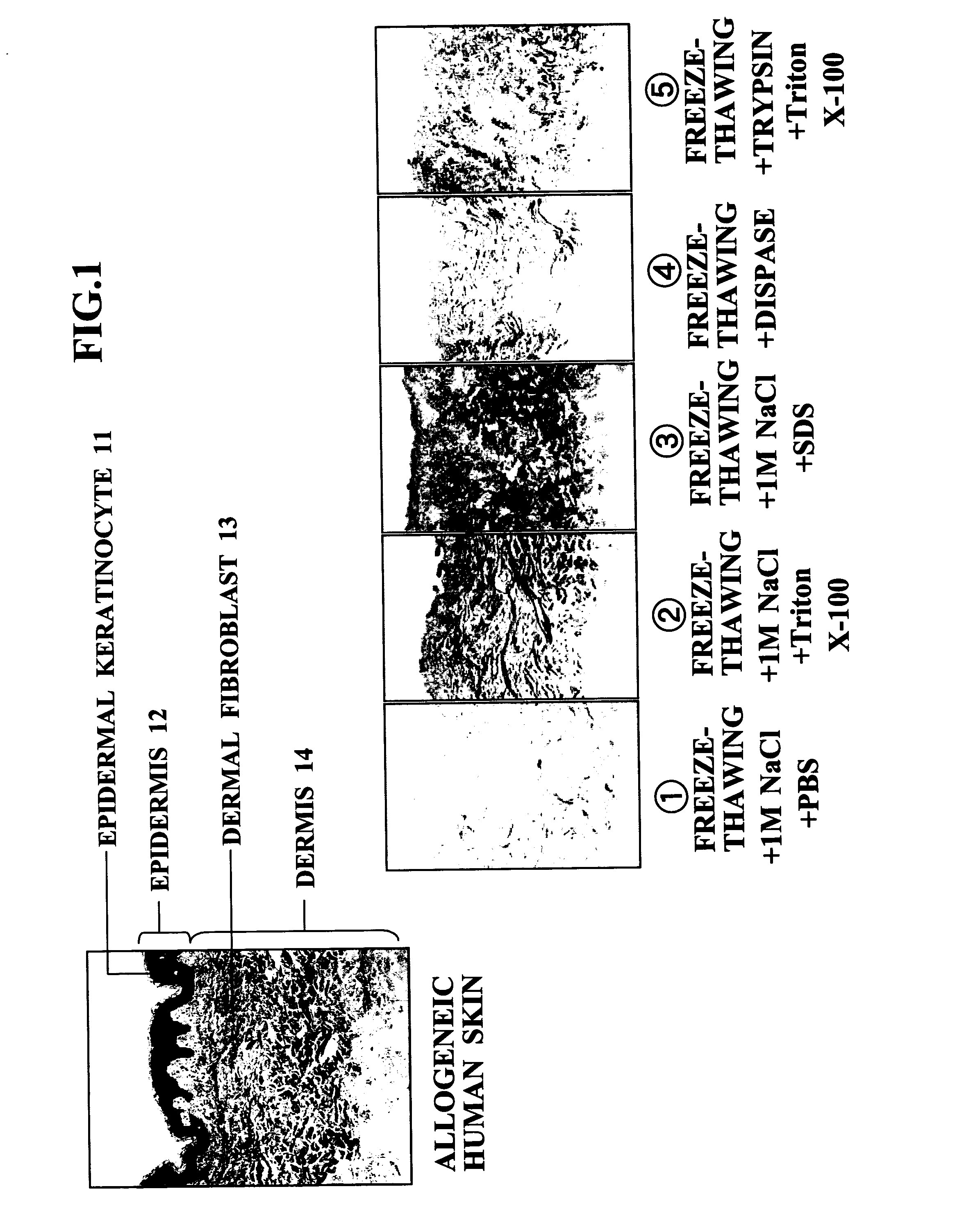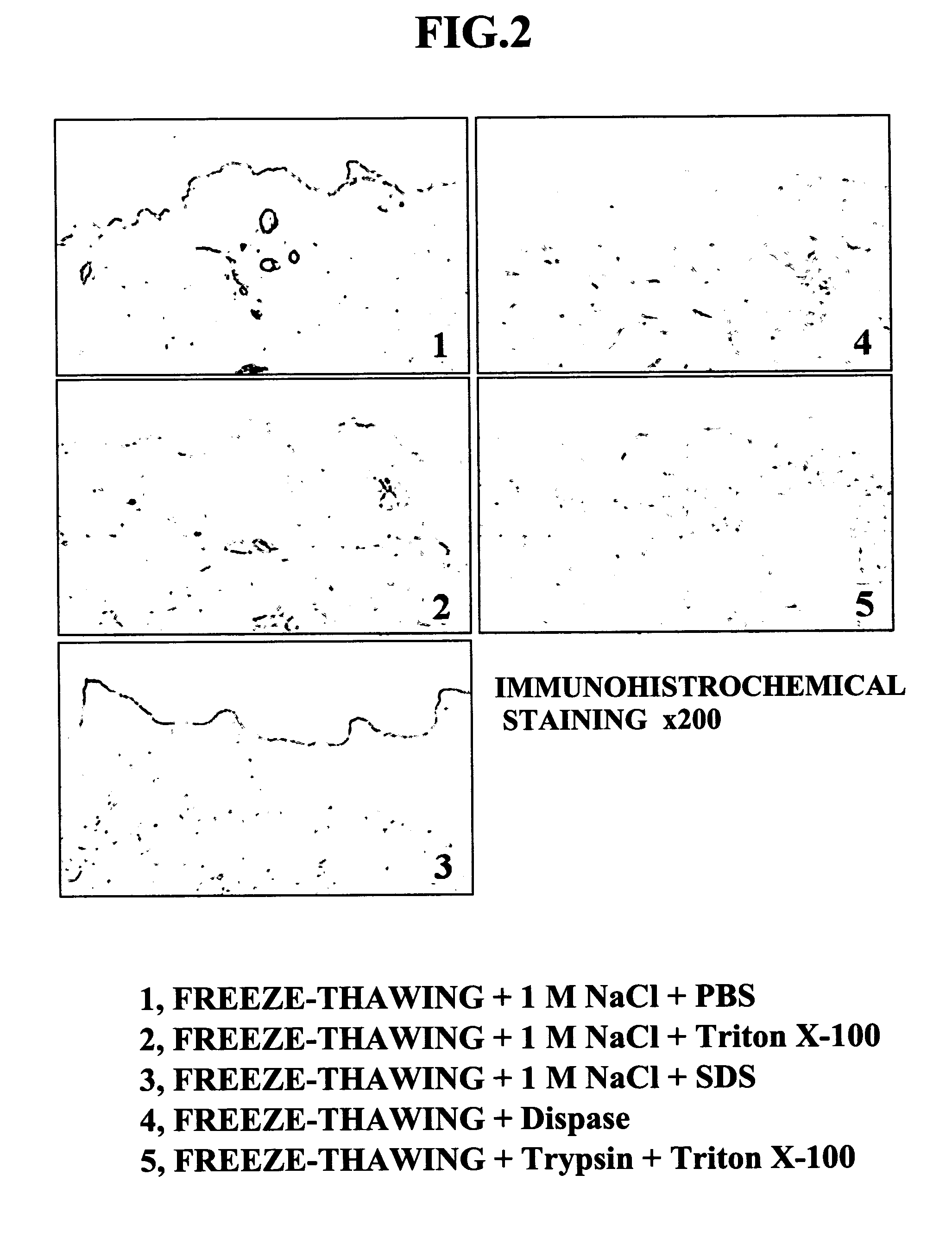Method of Preparing Isolated Cell-Free Skin, Cell-Free Dermal Matrix, Method of Producing the Same and Composite Cultured Skin with The Use of the Cell-Free Dermal Matrix
a technology of dermal matrix and cell-free skin, which is applied in the field of preparing isolated cell-free skin, cell-free dermal matrix, and producing composite cultured skin with the use of cell-free dermal matrix, can solve the problems of poor survival rate, epidermal peeling, and epidermal layer peeling, and achieves the effect of not causing any damage to the dermal matrix and easy peeling
- Summary
- Abstract
- Description
- Claims
- Application Information
AI Technical Summary
Benefits of technology
Problems solved by technology
Method used
Image
Examples
example 1
[0051] In order to examine the characteristics and advantages of the acellular dermal matrix production method of the present invention, it was compared with conventionally reported separation and decellularization methods.
Method 1 (1 M NaCl+PBS) (1)
[0052] Surplus skin (split-thickness skin: average thickness of about 0.38 mm: 0.015 inch thick) that was unwanted during surgery or after harvesting allogeneic skin was frozen using liquid nitrogen (at a temperature of −80° C. for 24 hours, and subsequently at a temperature of −196° C. for 48 hours), then thawed (at a temperature of 37° C. for 5 minutes), then immersed in 1 M NaCl, and incubated at 37° C. for 12 hours. This treatment allowed the epidermis and the dermis to be easily separated in a state in which the basement membrane remained in the dermis.
[0053] The dermal portion thus obtained was continuously washed using a TransWell with PBS (37° C.) for 1 week. This treatment allowed all the cellular components (cutaneous appe...
example 2
[0060] In accordance with FIG. 4, each of the ADMs obtained in Example 1 was seeded with fibroblasts, and then with epidermal keratinocytes, and the epidermal keratinocytes were overlayered by air-liquid interface culturing for 1 week, thus giving a composite cultured skin.
[0061] The properties of each composite cultured skin thus obtained were examined by carrying out H&E staining. FIG. 5 shows photographs of cross sections of the composite cultured skins after H&E staining. With regard to the composite cultured skin employing the ADM obtained by Method 1 as a scaffold, the epidermal keratinocytes were sufficiently overlayered, no peeling was observed between the epidermal keratinocytes and the ADM, and the attachment was good. With regard to the composite cultured skins employing the ADMs obtained by Methods 2 and 3 as a scaffold, the degree to which the epidermal keratinocytes were overlayered was slightly low, but no peeling was observed between the epidermal keratinocytes and ...
example 3
[0063] In accordance with FIG. 4, the composite cultured skin of the present invention and a composite cultured skin employing a conventionally developed scaffold were seeded with fibroblasts, and then with epidermal keratinocytes, and the epidermal keratinocytes were overlayered by air-liquid interface culturing for 1 week, thus giving a composite cultured skin. The animal collagen matrix referred to in Table 2 means a bovine-derived collagen gel or collagen sponge. The conventional ADM referred to here means an ADM obtained by a physical method involving freeze-thawing or a chemical method employing a protease such as trypsin or Dispase, or a detergent such as SDS or Triton X-100.
[0064] Subsequently, each composite cultured skin thus obtained was examined by H&E staining, and a comparison was made with respect to attachment after overlayering of epidermal keratinocytes and stability as a cultured tissue.
[0065] The composite cultured skin of the present invention exhibited the be...
PUM
 Login to View More
Login to View More Abstract
Description
Claims
Application Information
 Login to View More
Login to View More - R&D
- Intellectual Property
- Life Sciences
- Materials
- Tech Scout
- Unparalleled Data Quality
- Higher Quality Content
- 60% Fewer Hallucinations
Browse by: Latest US Patents, China's latest patents, Technical Efficacy Thesaurus, Application Domain, Technology Topic, Popular Technical Reports.
© 2025 PatSnap. All rights reserved.Legal|Privacy policy|Modern Slavery Act Transparency Statement|Sitemap|About US| Contact US: help@patsnap.com



